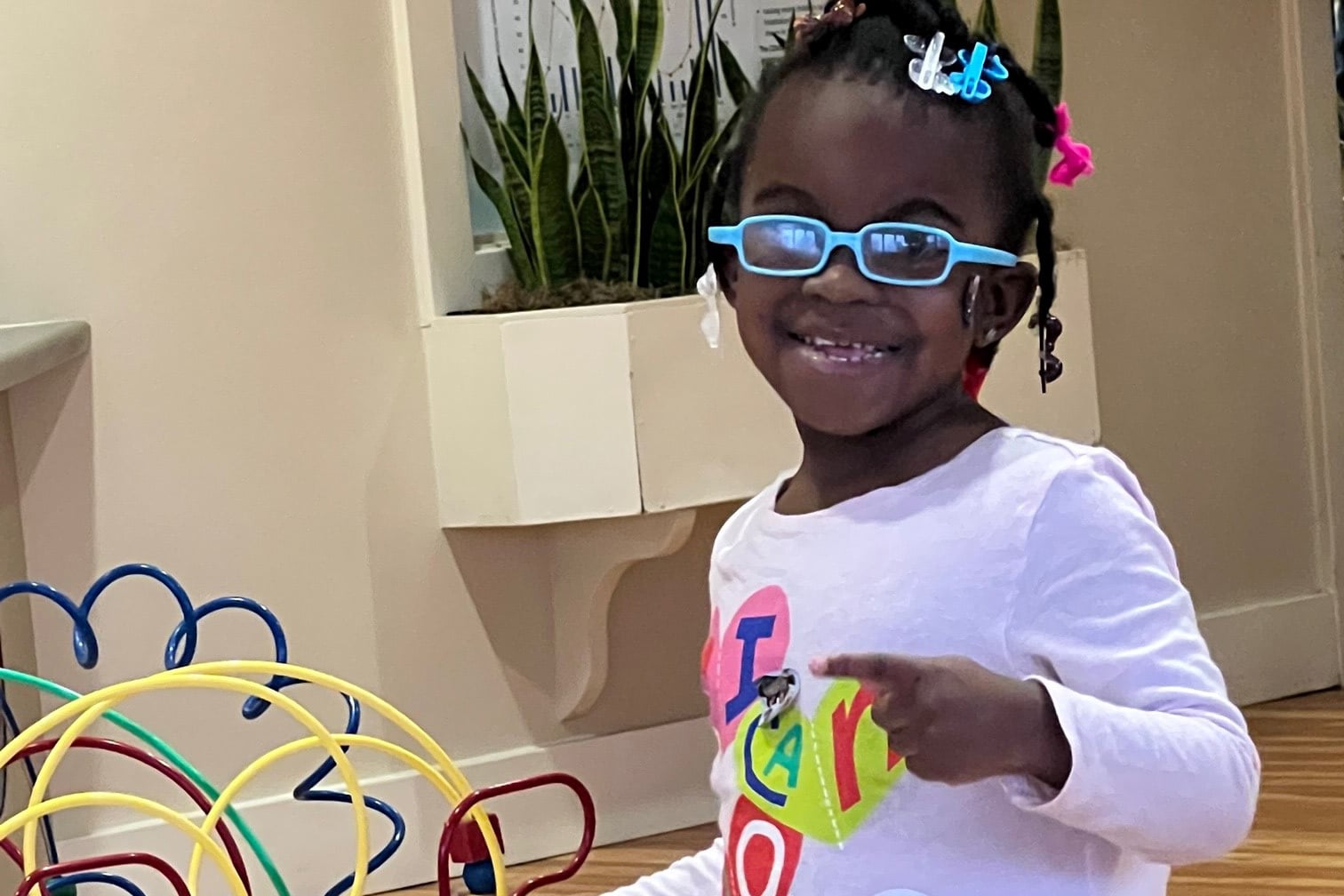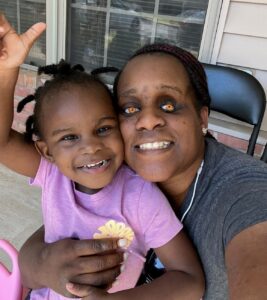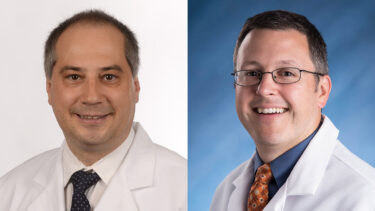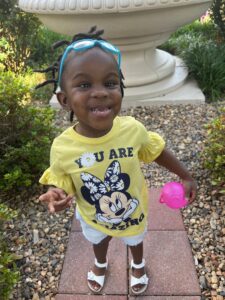View Larger Image

Three-year-old Dallas Carter was born with retinoblastoma, or cancer of the eye. After multiple surgeries and chemotherapy, she can see in both eyes and her cancer is in remission.
Image by Quatisa East
Three-Year-Old Patient Keeps Sight, Survives Rare Eye Cancer
| All Quatisa East wanted was for her infant daughter, Dallas Carter, to be able to see. A rare diagnosis of retinoblastoma, or cancer of the eye, threatened that possibility.
“I didn’t give up on her — everything I’ve done is just being a mother,” said the 29-year-old.
It’s been a long road for Dallas and her family, but today, the carefree 3-year-old can see in both eyes and her cancer is in remission. Getting there took a team effort from the University of Arkansas for Medical Sciences’ (UAMS) experts at the Harvey & Bernice Jones Eye Institute and the retinoblastoma program at Arkansas Children’s Hospital (ACH).

“I didn’t think that Dallas would actually have retinoblastoma,” East said. “I didn’t think she was going to be born with what I was born with.”Quatisa East
Retinoblastoma is a condition that East, who is blind, knows well. Diagnosed as an infant, she lost her right eye at five months of age and her left eye at 5 years old. Following radiation and chemotherapy, East has been cancer free for 25 years. Every five years, she travels to St. Jude Children’s Research Hospital in Memphis for checkups.
“I didn’t think that Dallas would actually have retinoblastoma,” East said. “I didn’t think she was going to be born with what I was born with.”
Retinoblastoma is the most common type of eye cancer in children, accounting for about 2% of all childhood cancers, according to the American Cancer Society. However, it is still a rare diagnosis — only about 200 to 300 children are diagnosed each year in the United States. Patients have vision problems and develop life-threatening tumors, which can spread to the rest of the body.
Sixty percent of children with retinoblastoma have only one eye affected. A smaller percentage of children inherit the disease, after receiving a gene mutation from a parent.
“We found out with Dallas the same time that I found out [as a child], at five months,” East said. “They scheduled an MRI and discovered that it was the same thing that I went through.” Two doctors teamed up to oversee Dallas’s care: Florin Grigorian, M.D., a pediatric ophthalmologist and assistant professor in the UAMS College of Medicine’s Department of Ophthalmology, and Kevin Bielamowicz, M.D., a pediatric oncologist and associate professor in the UAMS College of Medicine’s Department of Pediatrics. Both doctors primarily see patients at ACH, where Dallas received chemotherapy and much of her care.
“Dallas came to me as a little baby with a white pupil, and we confirmed that she had bilateral retinoblastoma,” Grigorian said. “She had numerous and advanced tumors in one eye as well as early retinoblastoma in the other eye. Working together with interventional radiology and ophthalmology teams at Arkansas Children’s and UAMS, we were able to overcome cancer and not only save both of Dallas’s eyes, but also her vision.”

UAMS doctors Florin Grigorian, M.D. (left), a pediatric ophthalmologist, and Kevin Bielamowicz, M.D. (right), a pediatric oncologist, oversaw Dallas’s care.Johnpaul Jones and Dero Sanford
A key component of Dallas’s treatments involved intra-arterial chemotherapy, in which chemotherapy is delivered directly into the ophthalmic artery, the primary blood supply at the back of the eye. This targeted therapy reduces the risk of developing side effects from the chemo, including other cancers later in life, Bielamowicz said.
“We are very excited to be able to provide comprehensive care for patients with retinoblastoma at Arkansas Children’s Hospital. Part if this treatment includes being able to administer intra-arterial chemo with our interventional radiology partners at UAMS. The ability to provide this state-of-the-art treatment is essential for care for patients such as Dallas to receive world-class care for retinoblastoma here in Arkansas,” said Bielamowicz.
Dallas’s treatment was extensive, involving more than 20 rounds of chemotherapy, as well as cryotherapy, monthly laser eye procedures, eyepatches and eye realignment. A recurrence of tumors in one eye required additional chemotherapy. COVID-19 restrictions also complicated the overall process. All the treatments were confusing for Dallas, and it took her time to adjust. It was difficult, East said, including a trip to the emergency room when Dallas pulled out the central line in her chest.
Finally, in January 2021, Dallas finished her treatments. This past March, doctors removed her port. Another milestone is coming soon: attending school.
“We didn’t know how good her vision was going to be, or if she was going to keep it — we didn’t know anything until the end,” East said. “It’s good and clear — she has vision and is cancer free now.”
Strong family support has been a central part of Dallas’s recovery. Father Eddie Carter, 28, is a big presence, as well as her maternal grandmother, three aunts and three uncles. Doctors cited her family as one of the major strengths in her recovery.
Dallas has better sight in her left eye, which was less affected by the cancer than her right eye. She continues to go through visual rehabilitation at the UAMS Eye Institute’s Low Vision Clinic. Like her mother, Dallas will need to have five-year follow-ups for the rest of her life to make sure the cancer doesn’t come back.
Today, Dallas can see, and that makes all the difference.
“She can run a lot more, jump and do everything now,” East said. “She knows how to ride a bike with training wheels. We have one of those remote cars that we would steer for her, but now she’s old enough to drive it herself. She knows her colors and shapes; she’s doing very well.”
Grigorian said he was impressed with how the family handled the diagnosis and was proud of how multiple cancer and eye specialists worked together to save Dallas’s sight.
“There is a 90% survival rate for this type of cancer, but the preservation of eyes and vision is less than perfect,” Grigorian said. “We came together as a team to take care of this complicated and challenging situation. It’s very inspiring to see intergenerational progress with this disease.”
